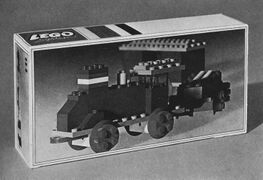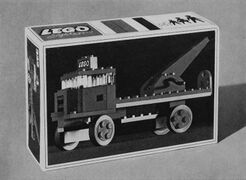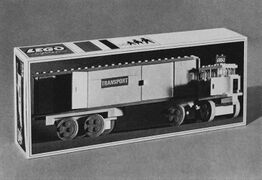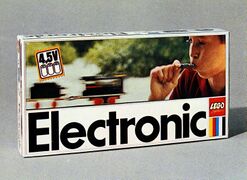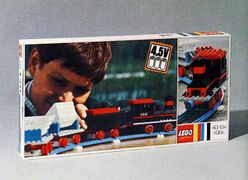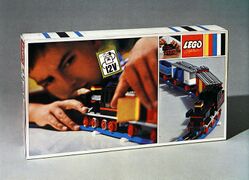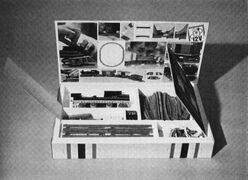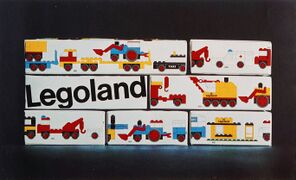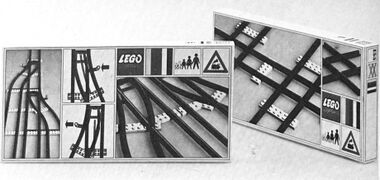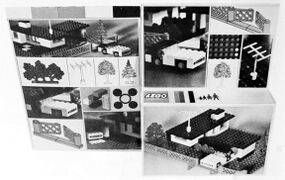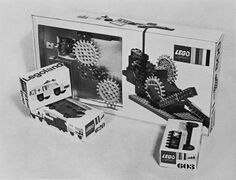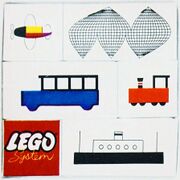Niels Hartmann: Difference between revisions
No edit summary |
No edit summary |
||
| Line 8: | Line 8: | ||
}} | }} | ||
'''Niels Hartzack Hartmann''' (9 April 1932–1978) was a Danish [[Wikipedia:Graphic designer|graphic designer]] and [[Wikipedia:Art director|art director]]. He worked in advertising in Denmark and Sweden and was known for his symbol and typography designs. During the late 1960s and 1970s he created packaging and print material for [[the LEGO Group]], and is credited with co-designing the 1973 LEGO logo. He is one of around 500 artists to have been a member of [[Wikipedia:Alliance Graphique Internationale|Alliance Graphique Internationale]]. | '''Niels Hartzack Hartmann''' (9 April 1932–1978) was a Danish [[Wikipedia:Graphic designer|graphic designer]] and [[Wikipedia:Art director|art director]]. He worked in advertising in Denmark and Sweden and was known for his symbol and typography designs. During the late 1960s and 1970s he created packaging and print material for [[the LEGO Group]], and is sometimes credited with co-designing the 1973 LEGO logo. He is one of around 500 artists to have been a member of [[Wikipedia:Alliance Graphique Internationale|Alliance Graphique Internationale]]. | ||
== Biography == | == Biography == | ||
Niels Hartmann was born on 9 April 1932 in the [[Wikipedia:Hellerup|Hellerup]] district of [[Wikipedia:Gentofte Municipality|Gentofte Municipality]], Denmark. He was the third child of Svend Hartzack Hartmann and Elna Tilling, and was considered to be part of the seventh generation of the Danish-Norwegian Hartmann family.<ref name=Fabritius/> He was educated in art at the [[Wikipedia:Danmarks Designskole|School of Arts and Crafts]]{{efn|{{lang-da|Kunsthåndværkerskolen}}, also called the School of Arts, Crafts and Industrial Design;<ref name="Bernsen"/> known since 1991 as the Danish Design School ({{lang-da|Danmarks Designskole}}).<ref name=dkds/>}} in [[Wikipedia:Copenhagen|Copenhagen]] from 1946–1950. In 1950 he established the studio Hartmann Design with his older brother Jørgen Hartzack, who was also a graphic designer.<ref name="DLPS Lego"/><ref name=Cooper/> Niels moved his work to [[Wikipedia:Helsingborg|Helsingborg]] in [[Wikipedia:Skåne|Skåne]], Sweden in 1958, to the Danish island [[Wikipedia:Als (island)|Als]] in 1959, and to [[Wikipedia:Malmö|Malmö]] in Skåne | Niels Hartmann was born on 9 April 1932 in the [[Wikipedia:Hellerup|Hellerup]] district of [[Wikipedia:Gentofte Municipality|Gentofte Municipality]], Denmark. He was the third child of Svend Hartzack Hartmann and Elna Tilling, and was considered to be part of the seventh generation of the Danish-Norwegian Hartmann family.<ref name=Fabritius/> He was educated in art at the [[Wikipedia:Danmarks Designskole|School of Arts and Crafts]]{{efn|{{lang-da|Kunsthåndværkerskolen}}, also called the School of Arts, Crafts and Industrial Design;<ref name="Bernsen"/> known since 1991 as the Danish Design School ({{lang-da|Danmarks Designskole}}).<ref name=dkds/>}} in [[Wikipedia:Copenhagen|Copenhagen]] from 1946–1950. In 1950 he established the studio Hartmann Design with his older brother Jørgen Hartzack, who was also a graphic designer.<ref name="DLPS Lego"/><ref name=Cooper/> Niels moved his work to [[Wikipedia:Helsingborg|Helsingborg]] in [[Wikipedia:Skåne|Skåne]], Sweden in 1958, to the Danish island [[Wikipedia:Als (island)|Als]] in 1959, and to [[Wikipedia:Malmö|Malmö]] in Skåne from 1960–1963. From 1963–1964 he worked with advertiser Thomas Bergsøe, then with Morten Peetz-Schou from 1965–1966; he was also a freelancer at the Danish Agricultural Marketing Board's advertising department.<ref name="DLPS Arcodan"/><ref name="DLPS Lego"/> In 1967 he became a member of Alliance Graphique Internationale (AGI); he was the first Danish member who became an established designer after [[Wikipedia:World War II|World War II]].<ref name="AGI Niels"/> That same year he opened his own studio, Niels Hartmann Industriel-grafik A/S, in the [[Wikipedia:Holte|Holte]] district of Copenhagen, and operated it until his death in 1978.<ref name="DLPS Lego"/><ref name="Photographis 69"/> | ||
Starting in the late 1960s Hartmann was involved in [[Dot Zero Designgroup]], a studio co-owned by the LEGO Group.<ref name="DLPS Lego"/> Some of Hartmann's employees who were co-designers for LEGO include [[Rolf Lagersson]] and Folkmar Roll.<ref name="Photographis 69"/> Some sources co-credit him as redesigning the LEGO logo with Rolf Lagersson in 1972, used from 1973–1998.<ref name="Lego history"/> | Starting in the late 1960s Hartmann was involved in [[Dot Zero Designgroup]], a studio co-owned by the LEGO Group.<ref name="DLPS Lego"/> Some of Hartmann's employees who were co-designers for LEGO include [[Rolf Lagersson]] and Folkmar Roll.<ref name="Photographis 69"/> Some sources co-credit him as redesigning the LEGO logo with Rolf Lagersson in 1972, used from 1973–1998.<ref name="Lego history"/> | ||
| Line 25: | Line 25: | ||
Photographis 69, Packaging 737.jpg | Set 720 packaging (opened), 1969 | Photographis 69, Packaging 737.jpg | Set 720 packaging (opened), 1969 | ||
Graphis – Packaging 3, Pastimes 434.jpg | Legoland cars packaging, 1970–1971 | Graphis – Packaging 3, Pastimes 434.jpg | Legoland cars packaging, 1970–1971 | ||
Modern Publicity 37, p120-121, Packaging 1b.jpg | |||
Modern Publicity 39, p86-87, Packaging 8.jpg | |||
Modern Publicity 40, p76-77, Packaging 6.jpg | |||
Modern Publicity 37, p120-121, Packaging 1a.jpg | |||
</gallery> | </gallery> | ||
Revision as of 15:58, 9 August 2024
Niels Hartmann | |
|---|---|
| Born | 9 April 1932 |
| Died | 1978 (aged 45–46) |
| Education | Kunsthåndværkerskolen |
| Occupation | Graphic designer |
| Years active | 1950–1978 |
Niels Hartzack Hartmann (9 April 1932–1978) was a Danish graphic designer and art director. He worked in advertising in Denmark and Sweden and was known for his symbol and typography designs. During the late 1960s and 1970s he created packaging and print material for the LEGO Group, and is sometimes credited with co-designing the 1973 LEGO logo. He is one of around 500 artists to have been a member of Alliance Graphique Internationale.
Biography
Niels Hartmann was born on 9 April 1932 in the Hellerup district of Gentofte Municipality, Denmark. He was the third child of Svend Hartzack Hartmann and Elna Tilling, and was considered to be part of the seventh generation of the Danish-Norwegian Hartmann family.[1] He was educated in art at the School of Arts and Crafts[a] in Copenhagen from 1946–1950. In 1950 he established the studio Hartmann Design with his older brother Jørgen Hartzack, who was also a graphic designer.[4][5] Niels moved his work to Helsingborg in Skåne, Sweden in 1958, to the Danish island Als in 1959, and to Malmö in Skåne from 1960–1963. From 1963–1964 he worked with advertiser Thomas Bergsøe, then with Morten Peetz-Schou from 1965–1966; he was also a freelancer at the Danish Agricultural Marketing Board's advertising department.[6][4] In 1967 he became a member of Alliance Graphique Internationale (AGI); he was the first Danish member who became an established designer after World War II.[7] That same year he opened his own studio, Niels Hartmann Industriel-grafik A/S, in the Holte district of Copenhagen, and operated it until his death in 1978.[4][8]
Starting in the late 1960s Hartmann was involved in Dot Zero Designgroup, a studio co-owned by the LEGO Group.[4] Some of Hartmann's employees who were co-designers for LEGO include Rolf Lagersson and Folkmar Roll.[8] Some sources co-credit him as redesigning the LEGO logo with Rolf Lagersson in 1972, used from 1973–1998.[9]
Gallery of works
-
Set 114 packaging, 1966
-
Set 332 packaging, 1967
-
Set 335 packaging, 1967
-
Set 118 "Electronic Train" packaging, 1968
-
Set 120 packaging, 1968
-
Set 720 packaging, 1969
-
Set 720 packaging (opened), 1969
-
Legoland cars packaging, 1970–1971
Notes
- ↑ Template:Lang-da, also called the School of Arts, Crafts and Industrial Design;[2] known since 1991 as the Danish Design School (Template:Lang-da).[3]
References
- ↑ Fabritius, Albert (1945). Slægterne Hartmann i Danmark og Norge [The Hartmann families in Denmark and Norway] (PDF) (in Danish). København: Generalkonsul Hjalmar Hartmann. p. 63. Archived (PDF) from the original on 2024-06-14. Retrieved 2024-08-06 – via Danskernes Historie Online.
- ↑ Bernsen, Jens; Capetillo, Birgitta, eds. (1988). Profession: Designer (Search results for "Kunsthåndværkerskolen"). Copenhagen: Dansk Design Center. ISBN 87-87385-40-6.
- ↑ "History - The Danish Design School". The Royal Danish Academy of Fine Arts. 26 January 2011. Archived from the original on 2011-07-19.
- ↑ a b c d "LEGO". Danish Logo Preservation Society. Archived from the original on 2018-02-21.
- ↑ Cooper, Al (1978). World of Logotypes: Trademark Encyclopedia Volume 2. Art Direction Book Co. p. H-23. ISBN 978-0-91015-834-3.
- ↑ Gyllan, Peter. "Arcodan". Danish Logo Preservation Society. Archived from the original on 2018-02-21.
- ↑ "Niels Hartmann, Denmark (1967)". Alliance Graphique Internationale. Archived from the original on 31 July 2024.
- ↑ a b Herdeg, Walter, ed. (1969). Photographis '69. New York: Hastings House. pp. 222–223. ISBN 0-8038-5750-0.
- ↑ "A modern, international company – LEGO History". LEGO.com. Archived from the original on 31 July 2024. Retrieved 5 August 2024.
